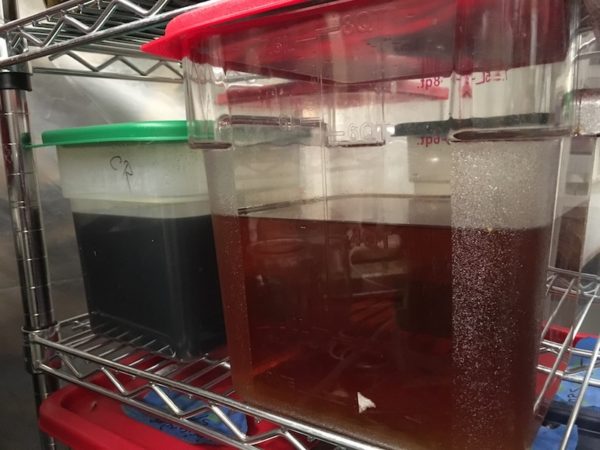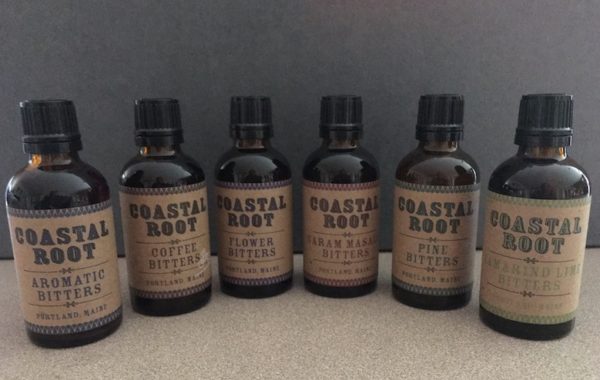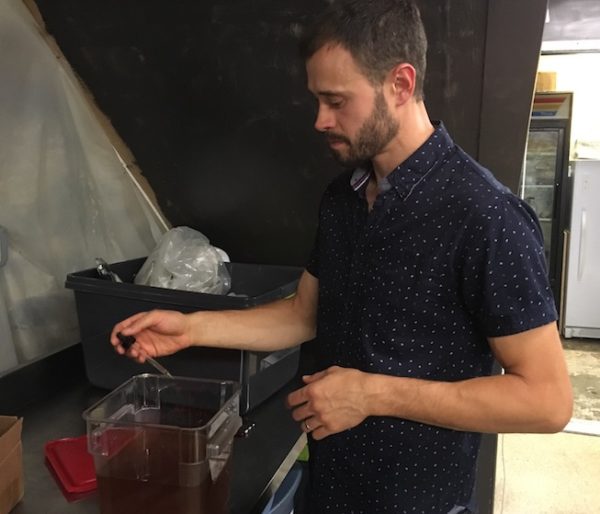I recently went through some old books in our barn and discovered Dr. Chase’s Receipt Book and Household Physician, published in 1898. In those days, receipts were prescriptions for medicinal preparations. One of the receipts I found inside was for Mrs. Chase’s Magic Tonic Bitters for Weak and Debilitated Females.
- 4 ounces best red Peruvian bard
- 4 ounces prickly ash bark
- Four ounces poplar root bark
- 1-ounce cinnamon bark
- 1/2 ounce cloves
- 2 quarts whiskey
- 2 quarts clear worked cider
- Grind all coarsely or bruise with a hammer.
- Put into the jug or bottle with the spirits and cider (or water, if no good cider can be had, but the cider is much the best).
- Shake daily for 10 days.
- Take out the dregs, either filter or strain and press out, as you choose.
- Take a wine glass of it immediately after each meal.
- The dregs steeped in 1 quart of water will yield considerably more strength, which may be added to the tonic bitters when strained off.
Did the remedy work? Apparently, the doctor thought so. He wrote: “I have made this for my wife several times and I did not fail to help her dispose of it occasionally myself. Her remark has often been: “Oh! What an appetite it gives me,” etc. It is a very valuable tonic and from the spices, very pleasant to take.”
The origins of bitters as medicine can be traced back to the ancient Egyptians, who, according to Wikipedia, may have “steeped medicinal herbs in jugs of wine.”
What are bitters, exactly? Again, from Wikipedia,
“A bitters is traditionally an alcoholic preparation flavored with botanical matter such that the end result is characterized by a bitter, sour, or bittersweet flavor.”
In the 1800s, not only were bitters used for “medicinal purposes,” they were also showing up in a new concoction — the cocktail. The first ones were a combination of spirits, sugar, bitters, and water. “It was basically a really rough punch that was given to people at political rallies to bolster their enthusiasm,” Nolan Stewart explained to me.

I recently visited Nolan in the basement of Vena’s Fizz House on Fore Street in Portland, Maine. It’s where Nolan brews up his own modern day version of bitters. He calls his business Coastal Root Bitters.
“The name is a shout out to the place where my bitters are being made and what they’re being made out of — roots, of course. I’m also sinking my personal roots into this place in the world. (He was raised in VT and moved to Maine in 2000.) And the name is sort of a nudge at a play on words for route one going up and down the coast. Bob Jordan designed the label. We graduated together from Maine College of Art and he’s now a graphic designer in NY.”
Nolan showed me his process for making bitters, talked about why he’s in the business and shared some recipes. Although he makes the bitters primarily for cocktails, he says there also good in mocktails and to dress certain dishes.
What got you started making bitters?
I worked at a beer, wine and liquor store for six years. It was gin that really got me thinking. Gin to me was always just a juniper-forward, aggressive spirit and I found out that there could be very ethereal light gins. It was a revelation. Seeing the different ways that botanicals could influence something was a real eye-opener.
I didn’t think anybody else was making bitters in Maine yet and there were more and more small distilleries popping up. I thought there would be a place for Maine bitters so I started playing around with it. Much like the homebrewer gone pro, I said ok, this is worth a shot.

How do you make your bitters?
To make his bitters, Nolan extracts the flavor of the various ingredients by infusing them in alcohol (usually 40 proof) at room temperature for two weeks. He follows up with a water extraction for two of his ingredients — sarsparilla root and cardamom seeds. There were pots of each boiling on the stove when I visited him. He infuses each ingredient separately, strains them, blends the ingredients, bottles the bitters and sticks on his labels.
He has containers filled with wonderful smelling ingredients. Originally he wanted to make a 100% local ingredient bitter, but once he started experimenting, he realized that he wanted to use some fairly exotic things that weren’t available locally. Except for the pine needles that he uses in his pine bitters. “I wanted to make one at least that was representative of Maine so I ended up making a pine bitter,” he told me. “I worked on it for about a year before I was finished with the recipe.”

What kind of bitters do you make?
After a lot of experimentation, mostly in his kitchen at home, Nolan perfected six bitters recipes:
Aromatic bitters
It’s something you would use in pretty much any drink and it’s the more or less the original bitter. Aromatic could mean a lot of different things but generally, it means warm spices and orange. I decided that I’d spin it a little bit in favor of what I personally really like, which is sarsparilla and cardamom. I just happened to be drawn to those flavors and luckily it turns out that other people are as well.
Coffee bitters
I was thinking about coffee and for some reason, wanted to use star anise and I realized it was because I like anisette with coffee, like a cookie or coffee. And then it made sense to me to add other things that remind me of coffee, so I used oak and chicory and orange and cocoa. Very, very roasty. The coffee bitter is definitely not at home in lighter drinks — it’s pretty intense.
Flower bitters
It’s pretty much 100% flowers, barring the vanilla which is technically a fruit, but I figured pretty close. It has vanilla, jasmine, chamomile, hibiscus, elderflower, sunflower petals, cornflower, and hops. I wanted it to be very floral and I used the vanilla as a sweet component to sort of carry all the other things along. Chamomile, jasmine, and vanilla are really the stars of the show. It’s nice all around and is terrific in seltzer water and also food. You could substitue it for vanilla extract, for example.
Garam masala bitters
This very much stays true to the Indian spice blend. I love making Indian food and I dove into this one with the idea that I would stay really true to it. It has all of the warm spices in it and works really well with rye and in tiki drinks and drinks that have a lot of different components that need a unifying element.
Pine bitters
The pine bitter has white pine, blue spruce, rosemary, grapefruit, and lemon juniper. I wanted to use all the things that remind me of pine and then also use some pine, of course. The pine needles are actually edible. They have a lot of vitimin C apparently. That’s one thing that I forage — friend’s houses, parks. I try to just trim off the tips and make sure not go too heavily in one place, always leave plenty behind.
Tamarind lime bitters
Wonderful stuff. It tastes salty and can taste sweet and sour. Doesn’t have savory but it hits a lot of the other spots on your palate. It has lime peel, lime fruit, orange, angelica root — actually quite a lot of angelica root because I wanted it to be at home in gin as well as tropical drinks. I use it in seltzer water, I use it in gin, in lemonade, limeade. I dress watermelon with it. It’s also good for finishing fish.
What you should know about bitters
They shouldn’t really be a big exclamation point in your drink or food or seltzer water or anything. It should really be sort of a hidden hand that changes the drink and makes it more cohesive.

Bitters recipes from Nolan
Northwoods Sour
- 1 oz lemon juice
- 3/4 oz simple syrup
- 1 1/2 oz bourbon
- 4 oz Allagash Curieux
- 4-6 dashes of Coastal Root Aromatic bitters
- Combine first three ingredients in a highball glass with a little ice and stir briefly to combine.
- Add beer and stir again.
- Dash of bitters on top.
Pineapple Lemonade
- 4 oz pineapple juice
- 1/2 oz lemon juice
- 4 oz sparkling water
- maple syrup to taste
Stir and add 4 dashes of Coastal Root Pine Bitters
Wheatberry pilaf
- 1/2 cup wheat berries
- 1/2 cup orzo
- 1 cup chopped onion
- 1/4 cup golden raisins
- 2 teaspoons minced garlic
- 1 teaspoon minced ginger
- 1 cup chopped cilantro
- 1/2 teaspoon cumin
- 1 teaspoon coriander
- 1 serrano chili (optional)
- 1/2 tablespoon coconut oil
- Coastal Root Garam Masala bitters
- Cook wheat berries and orzo in lightly salted water according to the instructions on the package
- Chill under cold water and refrigerate
- In medium-sized saucepan, add the coconut oil, sauté onion garlic and ginger over medium heat until soft and fragrant
- Add the cumin and coriander and stir briefly
- Add a little salt and pepper to your taste
- Add the rains, wheat berries, pilaf and cilantro. Reduce heat to low and stir until the mixture is warm all the way through
- When serving, top each serving with 2-3 dashes of Coastal Root Garam Masala Bitters.


Leave A Comment